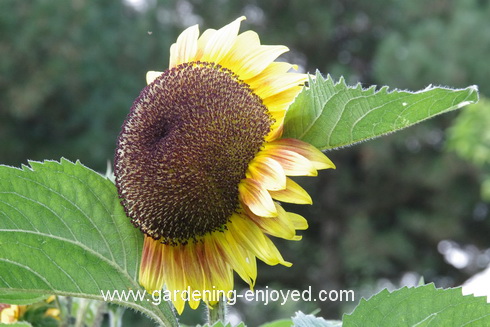
I love sunflowers but in my garden so do the slugs or some beastie that devours the leaves of the seedlings. This year, however, I had great success. I planted a whole row of Desert Sun, a variety I purchased from William Dam Seeds. They were direct seeded between the two rows of Potatoes as I thought they would grow up above the potato foliage, well did they ever. They are over 2 m tall with each holding one big flower and I can see more developing. They do irritate me slightly. Sunflowers are supposed to turn to face the sun as the sun moves. These ones really like to face East and do a very poor job of following the sun to the west. This matters because they are close to the fence on the east side of the yard and are making a wonderful display for those neighbours. Not that I don’t like to share, but!!
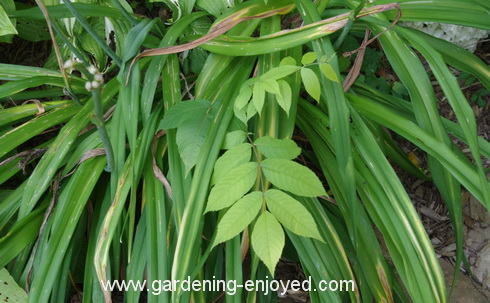
Our giant Walnut tree is both a blessing and a curse. Marvellous shade and a great place to grow shade loving plants such as Hosta. If you like squirrels, aka bushy tailed tree rats, then you will like this tree but they do eat some of the nuts and bury some of them for later. This results in Walnut seedlings being a frequent weed in the garden and you cannot pull them out without benefit of a trowel. I could transplant them and have a Walnut Orchard for whatever that’s worth.
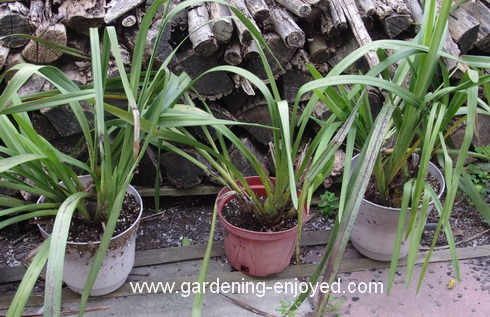
Last autumn I carried in five large pots of Cymbidium Orchids and they occupied a significant amount of space in the solarium. They produced exactly ONE stalk of blooms. The assistant gardener was suggesting that they may have outlived their welcome. A week or so ago I unpotted them and ripped them apart into the best looking three sections and put them in noticeably smaller pots. I’m hoping they will be rejuvenated and produce lots of blooms this winter, of course by dividing each pot into three I now have many more pots to deal with in the fall. Some of them may be looking for new homes.
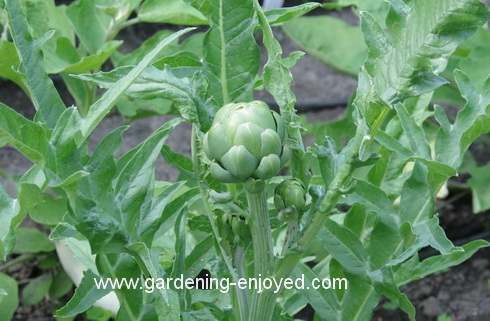
Back in the veggie garden some amazing things are happening and the crop of Artichokes in one of them. We produced six artichokes last year by the end of the summer and we have several more developing already this year. They are just a fun experimental crop to grow and the plants are quite interesting. We’ll be making that bowl of melted Garlic butter some day soon. Artichokes are actually a warm region perennial and Imperial Star is one variety that will produce in a single season so that we can grow them where it is too cold to have them overwinter.
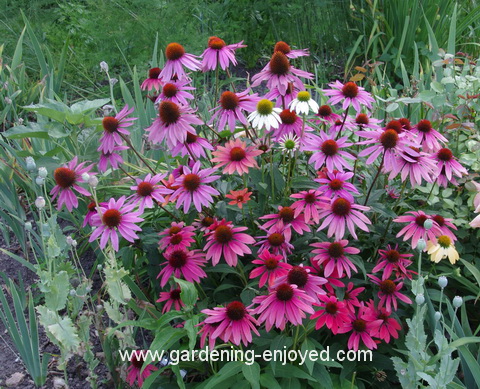
For some obscure reason Echinacea have never been a perennial that I liked. I think a lot of the older varieties always seemed to fade to the native light purple colour. A couple of years ago a film crew was shooting in my garden and they went to the local garden centre to get more colour and came back with several pots of Echinacea in different colours. They left them with me so I planted them. They are now providing some wonderful colour at a time of the year that not much else is really big and bright. This mixed clump has a bit of white and at least one yellow. I should try to separate them as those colours don’t compete as well as the reds. Echinacea has certainly moved up my approval list.
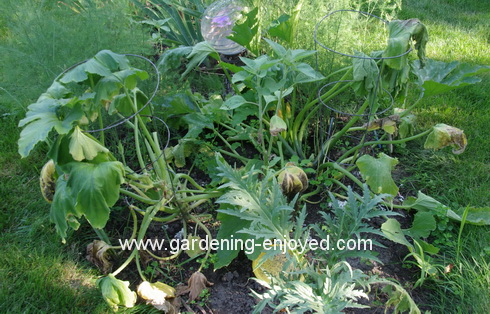
This is a pair of Zucchini plants that appear to be in some distress. They were growing quite well and adding to the daily superfluous harvest of fruits. A couple of days ago they suddenly started to dramatically wilt. I went looking for the telltale signs of the squash vine borer and could find no holes or frass. Then I looked up. They are just at the edge of the aforementioned Walnut tree and obviously their roots and the Walnut roots have found each other and the Zucchini are doomed. The Walnut roots secrete a chemical, juglone, that is quite toxic to a variety of other plants, especially, all the vining vegetables like Tomatoes, Cucumbers and all of the Squashes. We’ll survive as there doesn’t seem to be any shortage of Zucchini and we’ll plant something more tolerant there next year.
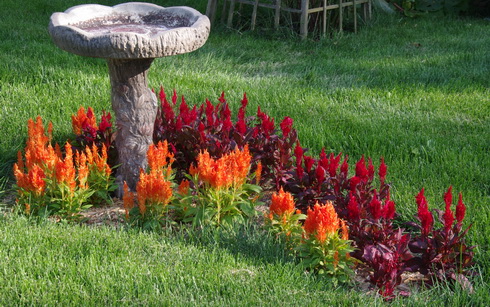
This little teardrop bed around the bird bath is a great place to try new annuals. This year it features a couple of new Celosia both of which came my way, as a trial, from All America Selections and so far they have been wonderful. C. Flamma Orange was an AAS winner in 2020. C. Burning Embers is a new Celosia that was a winner for 2024 and was bred for its gorgeous bronze foliage with dark pink veins that contrast nicely with the vibrant pink flower plumes. I haven’t done much with Celosia previously but I saw some of the new varieties at some trials in the last couple of years and was happy to try them out in my own garden. Both are relatively short and compact and they flowered early and continue to perform very well. I started their seeds on 25 March and they made it outside sometime in the middle of May. I’ll
probably keep them on my regular seed list. Why do I have a bird bath in the middle of a patch of lawn? How else would you mark the location of the municipal water shut off valve!
The roads are pleasant to drive on this time of year, as I am travelling around sharing my various presentations with hort. societies, garden clubs and corporate presentations for lunch and learns. I would love to come and visit your organization. Check out my web page at Gardening-enjoyed.com for more details on topics and availability.
If you have any gardening questions just “reply” to this emailed newsletter and I will attempt to answer them and then share them here if they are of wide interest.
Shirley Asks? Last year, my Dutch Master Daffodil tips came up in January and stayed until they pushed up further to bloom in their usual time. Of course, the tips were dead by the
time the flower buds appeared.
This year, the tips were already up in late November and in more than one bed - not all sheltered from cold winds, etc. Do you suppose the mild Fall weather has fooled them that it is Spring? I had never had this problem until the last few years or so.
Also, would you have any tips for getting rid of Muscari, (Grape Hyacinth)? They have spread everywhere! Aside from digging up the bulbs, I have not found anything else to discourage them, as even the bulbs as tiny as the eye of a needle put up leaves. For the past few years, I have deadheaded them, so at least they don't reseed, but found digging them out, so far, is the best I can do, except, now as an 88 yr-old, getting down on my knees is an impossibility. I am hoping for some kind of spray. (I know, I know, reaching for straws!!)
Ken Answers! At the risk of annoying any climate change deniers in my readership, that’s what is happening. Warmer
winters along with the lack of the insulating blanket of snow will induce many things to bloom early and for some things like your Daffodils that early growth is actually a bad thing. Dig them all up and move further north and replant them. That’s a touch impractical but might work:-)
The easy answer to your Muscari is just to learn to like them which you probably do until they all start to die down and look a touch messy. You can try mowing them as close to the ground as soon as they appear in an attempt to keep the leaves from getting big enough to regenerate the bulbs, a bit of a multi year process and possibly not practical for someone as young as you. There is nothing you can spray that would not also kill everything else it landed on. I have the same problem with Scilla and I just keep lots of healthy grass growing in the same spots so it will cover up the fading bulbs.







